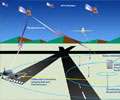
The Global Positioning System
What is GPS?
The Global Positioning System (GPS) is a U.S.-owned utility that provides users with positioning, navigation, and timing (PNT) services. This system consists of three segments: the space segment, the control segment, and the user segment. The U.S. Space Force develops, maintains, and operates the space and control segments.
-
Space Segment
 The space segment consists of a nominal constellation of 24 operating satellites that transmit one-way signals that give the current GPS satellite position and time.
Learn more
The space segment consists of a nominal constellation of 24 operating satellites that transmit one-way signals that give the current GPS satellite position and time.
Learn more
-
Control Segment
 The control segment consists of worldwide monitor and control stations that maintain the satellites in their proper orbits through occasional command maneuvers, and adjust the satellite clocks. It tracks the GPS satellites, uploads updated navigational data, and maintains health and status of the satellite constellation.
Learn more
The control segment consists of worldwide monitor and control stations that maintain the satellites in their proper orbits through occasional command maneuvers, and adjust the satellite clocks. It tracks the GPS satellites, uploads updated navigational data, and maintains health and status of the satellite constellation.
Learn more
-
User Segment
 The user segment consists of the GPS receiver equipment, which receives the signals from the GPS satellites and uses the transmitted information to calculate the user's three-dimensional position and time.
Learn how GPS is used
The user segment consists of the GPS receiver equipment, which receives the signals from the GPS satellites and uses the transmitted information to calculate the user's three-dimensional position and time.
Learn how GPS is used
GPS Services
GPS satellites provide service to civilian and military users. The civilian service is freely available to all users on a continuous, worldwide basis. The military service is available to U.S. and allied armed forces as well as approved Government agencies.
-
Augmentations
 A variety of GPS augmentation systems and techniques are available to enhance system performance to meet specific user requirements. These improve signal availability, accuracy, and integrity, allowing even better performance than is possible using the basic GPS civilian service.
Learn more
A variety of GPS augmentation systems and techniques are available to enhance system performance to meet specific user requirements. These improve signal availability, accuracy, and integrity, allowing even better performance than is possible using the basic GPS civilian service.
Learn more
-
Performance
 The outstanding performance of GPS over many years has earned the confidence of millions of civil users worldwide. It has proven its dependability in the past and promises to be of benefit to users, throughout the world, far into the future.
Learn more
The outstanding performance of GPS over many years has earned the confidence of millions of civil users worldwide. It has proven its dependability in the past and promises to be of benefit to users, throughout the world, far into the future.
Learn more
 Official U.S. government information about the
Global Positioning System (GPS) and related topics
Official U.S. government information about the
Global Positioning System (GPS) and related topics




